![]()
Contents: Basics; Antenna Issues; Bonding Material; Coaxial Connections; Fasteners; Insulating Varnish; Potting Material; SeeSnake; Shielding; Tools; Washers; Wiring; Odds & Ends;
The above speaks for a lot of us old-timers, as we've all learned a few tricks over the years. However, newcomers might not be aware of some of them. So here they are broken down into several categories.
 Just as important are the don'ts of the trade! One of those is covering coax and electrical connections with vinyl electrical tape. That's a really poor idea as outlined below. Another is using vehicle wiring to power amateur radio gear. Yet, these don'ts of the trade are common place. Hopefully, the information below keep a few folks from making mistakes, both costly and troublesome.
Just as important are the don'ts of the trade! One of those is covering coax and electrical connections with vinyl electrical tape. That's a really poor idea as outlined below. Another is using vehicle wiring to power amateur radio gear. Yet, these don'ts of the trade are common place. Hopefully, the information below keep a few folks from making mistakes, both costly and troublesome.
Tools! Tools! Tools! To do any job requires the correct tool for that job. No doubt the best example are the common screwdriver types—standard and phillips. Just think about them for a moment, and you'll get the point! And that is the best trick of all—the right tool for the right job!
By the way, contrary to popular belief, both straight and phillips screwdrivers come in metric sizes. If you do bench work on any late-model transceiver, you'll need several sizes of each type. You should also lay in a set of Torq® drivers, from size T1, all the way up to size T50. The latter sizes are used to remove automotive seat bolts, and other heavy-duty fasteners.
Here's a shameless plug. There is a company in Denver, called Tecra Tools. They've been in business since 1975. While they sell wrenches, drills, and other heavy-duty tools, their primary business is the communications industry. From soldering irons, to snipers, metric screwdrivers, Allen wrenches, you name it, they have it! But that's not all! They sell one tool every amateur should have—a pair of serrated scissors! They're often called lineman's scissors, and they sell for about $15 delivered. Those two small grooves are used for stripping telephone wire, but they work equally well for sizes up to #18. Once you opt for a pair, and you use them, you'll soon discover all of the other amateur uses they have. A good example is easily cutting through tinned-copper braid. By the way, they're great for deboning chicken so buy your wife a pair too!
There are a few more shameless plugs below. You can buy cheaper products in some cases, but what's here works as advertised.
The old adage about a chain being only as strong as its weakest link is true, and that speaks for antennas as well. I've been lucky, and I've never lost an antenna due to a component failure. However, I have a few friends who have. There are several scenarios which can cause an antenna failure, and one of those is the lowly 3/8x24 stud.
Some stainless steel ones are okay, as they have a tensile of about 60,000 psi. The black ones sold by most hardware stores have very low tensile strength (<20,000 psi), and they rust easily, so avoid them. If you have a heavy antenna, and you're worried about the bottom stud or bolt breaking, here's a suggestion. Most Ace hardware stores carry Grade 8 bolts in 3/8x24. The head of the bolt will have 6 hash marks, and they're usually plated with an anti-corrosive which gives them a yellow/green hue. If you need a 3/8x24 stud, you can easily cut the heads off and polish them with a Dremel tool. With a tensile of 150,000 psi, they're not liable to fail.
As popular as the Hustler® HF mobile antenna are, they still have several drawbacks. For example, the coils are held on the mast by a pressed-in stud with about 5 complete threads. If you overly tighten the coils, the ferrule will eventually loosen inside the mast. The result is a lost coil, and possible damage to those vehicles behind you. The safest way to make sure you don't lose one, is to guy the coil. Just make sure the material you use is not RF conductive! Phillystrand®works well as long as it isn't wet. Speaking of wet, moisture tends to collect under the vinyl covering over the Hustler® coils. If this happens, and you continue to transmit, you could arc over the coil with predictable results.
Almost all whips used in amateur antennas are made of 17-7 stainless steel. Some are plated to enhance conductivity, but all are lossier than aluminum. Problem is, you can't buy "springy" aluminum! If the antenna in question is a VHF one, the Larsen® is the answer. All of their antennas are available with what they call Kulrod®. The whips are plated with copper, with an outer cover of paint to protect the copper from corroding.
One might ask, why not have the whip plated? You can, but it isn't cheap. Copper won't stick to stainless steel, so the whip has to be plated with nickle first, then copper, then a nickel plating to retard corrosion. Finding someone to do it isn't easy either, and it typically costs about $100. All for very little gain.
An alternative to whip, is an aluminum mast and adequately sized, and well placed cap hat. If you read the article, you'll learn the benefits, as well as the drawbacks.
Every HF mobile antenna should have a corona ball. The problem is, most are too small to do the job they're supposed to do. As a general rule, anything smaller than 1/2 inch isn't worth the effort, especially if the retaining screw in in the side of the ball. If you live in a dry and/or dusty climate, you might be surprised how well corona balls and static drains work. There is more information on them in the linked article.
 Flat, braided copper strapping isn't as difficult to find as some folks think. In most cases the shield salvaged from discarded RG8 will do just fine. You can lightly score the outer cover with a utility knife which will allow you to remove it. Just be careful not to cut clear through to the shield. The older the coax is, the easier the job. Sometimes, the shield turns dark due to migration and contamination from the plasticisers in the outer cover. It can be easily removed with DipIt® or other tarnish removing liquid. Just remember to rinse and dry it before you try to solder lugs onto it.
Flat, braided copper strapping isn't as difficult to find as some folks think. In most cases the shield salvaged from discarded RG8 will do just fine. You can lightly score the outer cover with a utility knife which will allow you to remove it. Just be careful not to cut clear through to the shield. The older the coax is, the easier the job. Sometimes, the shield turns dark due to migration and contamination from the plasticisers in the outer cover. It can be easily removed with DipIt® or other tarnish removing liquid. Just remember to rinse and dry it before you try to solder lugs onto it.
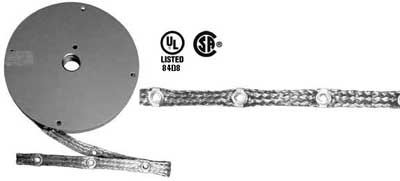 If you're after the braided heavy-duty, 1 inch wide material, you can buy that from HRO, and most other amateur radio dealers. Or, you might look here: Electric Motion. Their EM2080 product has eyelets crimped along its length which facilitates installation.
If you're after the braided heavy-duty, 1 inch wide material, you can buy that from HRO, and most other amateur radio dealers. Or, you might look here: Electric Motion. Their EM2080 product has eyelets crimped along its length which facilitates installation.
 3M's 1181 copper foil tape isn't technically bonding material, but it is good for shielding all sorts of RFI sources. The adhesive is conductive,and it solders very easily. Type 1182 has adhesive on both sides for special applications, and there is also an aluminum version (1170). All come is various widths with 3/4 and one inch the most common sizes. It isn't inexpensive, but you can often find it discounted on ebay and other on-line auction sites. By the way, the edges 1181 are very sharp, so be careful when applying it. Also, to assure a good electrical connection, burnish the edges with a tooth brush or similar device.
3M's 1181 copper foil tape isn't technically bonding material, but it is good for shielding all sorts of RFI sources. The adhesive is conductive,and it solders very easily. Type 1182 has adhesive on both sides for special applications, and there is also an aluminum version (1170). All come is various widths with 3/4 and one inch the most common sizes. It isn't inexpensive, but you can often find it discounted on ebay and other on-line auction sites. By the way, the edges 1181 are very sharp, so be careful when applying it. Also, to assure a good electrical connection, burnish the edges with a tooth brush or similar device.
Sanding off paint down to bare metal to assure a good connection, is not advisable! Doing so defeats the rust-preventing, self-healing property of the underlying zinc coating. The best way to assure a good connection, is use a star washer between the body and/or frame, and any attachment device, electrical or otherwise. If you can find them, use the I/O style with teeth on the inside and outside as shown above right. Remember, zinc is self healing, so once you tighten down the connection, the zinc will do its thing and seal the connection from the elements. Speaking of which, don't paint or apply any material over the connection! Doing so just seals in the moisture, and prevents the zinc from oxidizing, which is exactly what you want it to do!
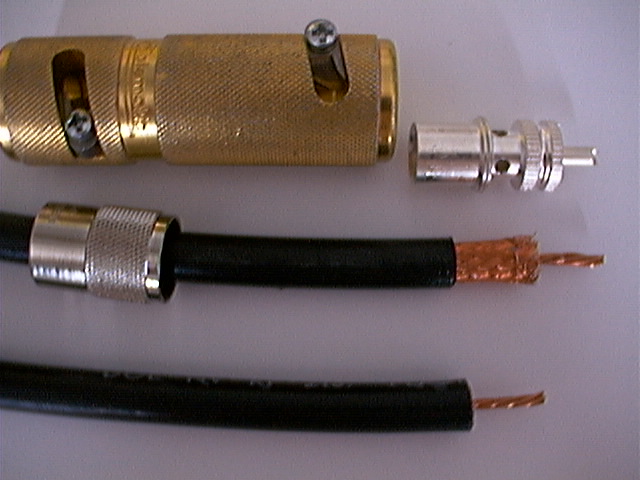 This article explains how to properly install UHF (PL259) coax connectors. It includes the use of a special coax prep tool (shown at right) which trims the end of the coax to the exact dimensions. This facilitates properly installing the PL259—the second most important step after soldering! This is especially true when using an adaptor sleeve (U180X series) for the smaller diameter RG58 and RG 59 (RG8X) cables.
This article explains how to properly install UHF (PL259) coax connectors. It includes the use of a special coax prep tool (shown at right) which trims the end of the coax to the exact dimensions. This facilitates properly installing the PL259—the second most important step after soldering! This is especially true when using an adaptor sleeve (U180X series) for the smaller diameter RG58 and RG 59 (RG8X) cables.
 The aforementioned does not apply to connectors designed specifically for crimping, like the one shown left from The RF Connection. However, the proper crimp tool (discussed below) is necessary to make sure the crimp is secure, and water tight. These specific connectors require that the center pin be soldered, and are much preferred over the crimp-on ones.
The aforementioned does not apply to connectors designed specifically for crimping, like the one shown left from The RF Connection. However, the proper crimp tool (discussed below) is necessary to make sure the crimp is secure, and water tight. These specific connectors require that the center pin be soldered, and are much preferred over the crimp-on ones.
 For some unknown reason, amateur radio operators think coax connections must be sealed to prevent moisture intrusion. The truth is, if you properly install them sealing isn't necessary. Proper installation includes the use of double-walled, polyolefin heatshrink tubing (5/8 inch ID in this case). It isn't inexpensive (about $9 per foot), so not too many people use it. But if you just have to feel warm and fuzzy, then use Rescue Tape®. It is self vulcanizing, and will seal out the weather like no other product, bar none! It is almost magical! The best part is, it is easy to remove when necessary. You can buy it directly, of at most Ace Hardware stores.
For some unknown reason, amateur radio operators think coax connections must be sealed to prevent moisture intrusion. The truth is, if you properly install them sealing isn't necessary. Proper installation includes the use of double-walled, polyolefin heatshrink tubing (5/8 inch ID in this case). It isn't inexpensive (about $9 per foot), so not too many people use it. But if you just have to feel warm and fuzzy, then use Rescue Tape®. It is self vulcanizing, and will seal out the weather like no other product, bar none! It is almost magical! The best part is, it is easy to remove when necessary. You can buy it directly, of at most Ace Hardware stores.
One thing you don't want to use, although most amateurs do, is vinyl electrical tape—no matter the brand, no matter the part number! Contrary to popular belief, it allows moisture to seep in, and even the really good grades tend to harden over time. Plus, there is always a residue left when you remove it. This is also true of coax seal, dum-dum, and just about every other tape product, except Rescue Tape®.
One thing you want to be very careful about, is using one of the myriad of alternative ways to solder on PL259s, even when they appear in national publications. Rather, learn to do it correctly instead of having to relearn later, and here's why. At HF, you can get by with almost anything, but by the time you get to about 30 MHz (the start of the VHF band), the importance of following Amphenol's® recommendations becomes very apparent in the reflection coefficient (increase in SWR). The issue here is simply this. If you follow the directions, a PL259 is usable well past the 300 MHz assumed limit.

 There are about as many different kinds of fasteners in the world as there are people, or so it seems. All the rage these days are self drilling, sheet metal screws. They're great for thicker materials, but if you're using them on thin sheet metal, they don't work very well. The best solution is to use a very sharp punching tool and hammer, which will roll the edges of the sheet metal over as the punch is driven through as shown at the right. This gives a sheet metal screw (self drilling or otherwise) a larger surface to grip onto, and less likely to loosen.
There are about as many different kinds of fasteners in the world as there are people, or so it seems. All the rage these days are self drilling, sheet metal screws. They're great for thicker materials, but if you're using them on thin sheet metal, they don't work very well. The best solution is to use a very sharp punching tool and hammer, which will roll the edges of the sheet metal over as the punch is driven through as shown at the right. This gives a sheet metal screw (self drilling or otherwise) a larger surface to grip onto, and less likely to loosen.
You can buy all kinds of screws, bolts, fasteners, clips, etc. from your local Ace Hardware. However, if you're looking for something really off-beat, here's a good source; Fastener Super Store. They even accept PayPal if you're into such things. Incidentally, they carry the aforementioned I/O star washers.
Another good source is Aaron's. They carry a very wide assortment of both inch and metric sized bolts, nut, washers, and fasteners. Even the really weird security items which are seemingly impossible to find.
We all need to thank Thomas & Betts for the Ty-Rap®. The problem is, not all plastic ties are made by T&B, and in most cases the off-brand ones are inferior. If you visit their web site, you'll learn why. Honest-to-john Ty-Raps® utilize a metal keeper rather than a plastic one which makes them ever so much stronger. You should select the all-weather ones which have ultraviolet stabilizers for long life.
If you don't mind paying the premium, you can buy T&B Ty-Raps® that have a metal core running along their length. So help me, you can almost tow a car with one of them! Their web site lists their distributors, including GrayBar Electric. By the way, Ty-Raps® are available with eyelets in the ends, so they can be screwed down. I've tried those plastic clips which use double-sided sticky tape, but they fail in due course.
 As mentioned above, do not cover coax connectors with vinyl tape or similar products. This is especially important in a mobile environment. However, there are times you want to protect a soldered or crimped connection when you can't use heat shrink tubing, and here's the solution.
As mentioned above, do not cover coax connectors with vinyl tape or similar products. This is especially important in a mobile environment. However, there are times you want to protect a soldered or crimped connection when you can't use heat shrink tubing, and here's the solution.
Sprayon™ division of Sherwin-Williams sells a clear (also available in red and green), insulating varnish in a 12 oz. spray can. Its finished surface is much more eye-appealing than red glyptal, and doesn't peal or age. Its good to over 100°C, so it can be used underhood as well. It retails for ≈$10, has a high dielectric strength of about 2,200 volts per mil. It's RF transparent to about 1 GHz, so it can be used to protect any insulating material, RF, or DC. If applied properly, it won't harm most plastics. It might discolor some materials, so proper masking is essential. Remember too, it is an insulator!
There are similar spray-on acrylic lacquers, but they tend to be rather pricey (≈$35 per 12 oz. can). They too are advertised to have high dielectric strength, but whether they're good at RF is unknown. By the way, stay away from spray-on coax seal, unless you like gooey messes!
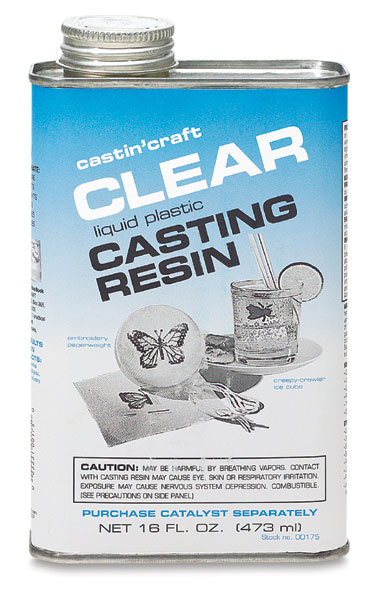
 There are times when you want to encapsulate (pot) your favorite project, and here are two products that will do the job inexpensively. Craftin'Craft's® Clear® casting, polyester resin is very easy to use and clean up after at least until it hardens. It's a bit brittle when hard, so drilling isn't advised. It seems to work very well up to about 30 MHz, and may well work into the UHF range. It comes in two parts, so don't forget the hardener which is sold separately.
There are times when you want to encapsulate (pot) your favorite project, and here are two products that will do the job inexpensively. Craftin'Craft's® Clear® casting, polyester resin is very easy to use and clean up after at least until it hardens. It's a bit brittle when hard, so drilling isn't advised. It seems to work very well up to about 30 MHz, and may well work into the UHF range. It comes in two parts, so don't forget the hardener which is sold separately.
Craftin'Craft® also makes EasyCast® clear casting epoxy. This stuff sticks to anything it touches, and makes cleanup difficult. It gets hotter than Clear® while setting up so you want to be careful using it with some easily-melted materials. Its much harder setting than Clear®, and the finished product can be drilled and tapped without breaking. You have to be careful doing so in any case.
Both products can be colored if desired, and both products and their colorants can be purchased from Wal-Mart®, Hobby Lobby®, and most hobby shops. Prices vary depending on the quantity purchased, but start at about $20 per pint.
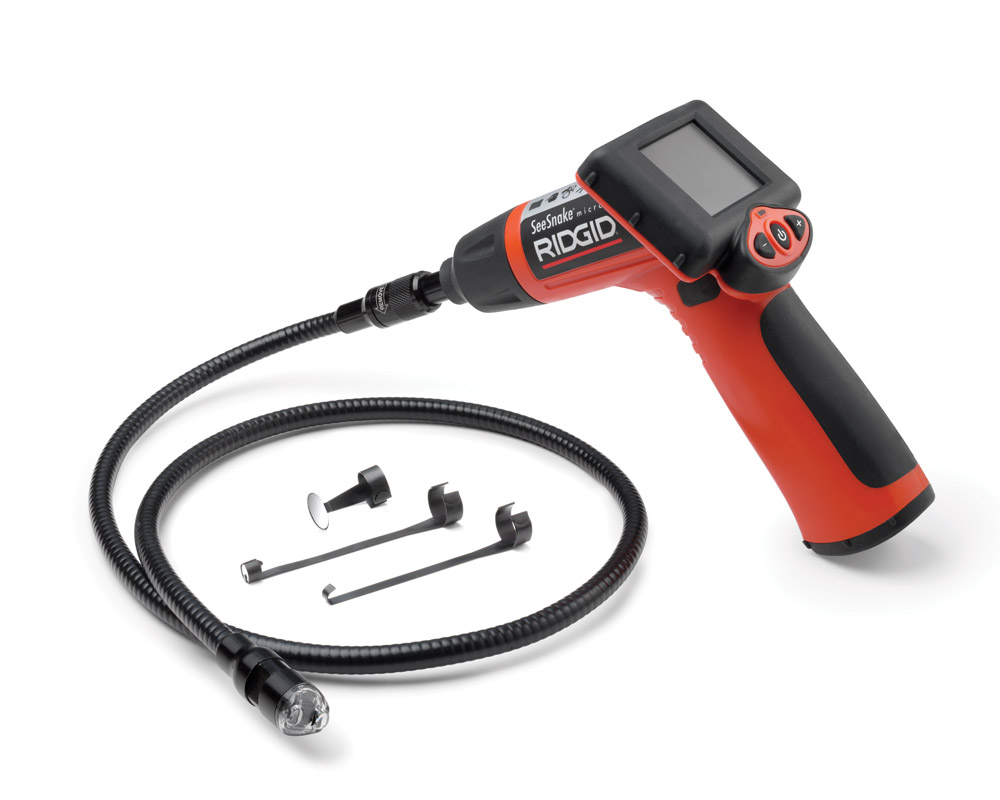 About 5 years ago, Home Depot ran a special on Rigid Tools' SeeSnake Micro® (model 26743), their entry level inspection camera for $69.99 (now $175 list). It was an impulse buy on my part, but I do like gadgetry so I justified buying it. I've used it a couple of times, even though I really didn't need to. That is, until I dropped a screwdriver into the engine compartment or my Ridgeline, and I couldn't see it from top or bottom. Out came the SeeSnake! Once I located the screwdriver, retrieving it with a magnet was easy. I'm not suggesting you run right out and buy one, but you'll know when it's time!
About 5 years ago, Home Depot ran a special on Rigid Tools' SeeSnake Micro® (model 26743), their entry level inspection camera for $69.99 (now $175 list). It was an impulse buy on my part, but I do like gadgetry so I justified buying it. I've used it a couple of times, even though I really didn't need to. That is, until I dropped a screwdriver into the engine compartment or my Ridgeline, and I couldn't see it from top or bottom. Out came the SeeSnake! Once I located the screwdriver, retrieving it with a magnet was easy. I'm not suggesting you run right out and buy one, but you'll know when it's time!
Here's a related suggestion. Rather than go out and buy all manner of tools, buy the normal complement like soldering irons (no guns please), screwdrivers, pliers, crimpers, cutters, etc. Then, when the time comes, when you need a specialized tool like the SeeSnake Micro®, buy it! Unless of course, you're a gadget-obsessed, radio amateur fanatic like I am!
Shielding late-model ignition systems is a waste of time, money, and effort. In fact, in some cases doing so will interfere with the timing sequence. This fact can cause the MIL (Maintenance Indicator Light) to illuminate. This includes GM V8 GenIII and Gen IV systems. Rather, it is best to properly bond the hood, and exhaust system, and hope for the best.
If you want to try shielding ignition wires in systems that utilized plug wires, here's a few tips. Discarded RG8 braided shielding works well for the purpose. However, be advised that sometimes it works, and sometimes it doesn't. The same goes for marine wiring kits. Part of the problem is leakage through the insulation to the shield. This can cause more RFI, not less as would be assumed. If you decide to shield your older model vehicle, don't shield the existing wiring. Rather, start with a new set of wires (and plugs too). This lessens the possibility of leakage, and gives you time to take your time to do it correctly. The shield should be grounded only on one end, typically at the plug. Don't use 3M 1181 for this, as it greatly stiffens up the cable assembly. Again, it might not be worth your effort, so consider it a last ditch effort to control ignition RFI.
By the way, bonding and shielding tend to be ineffective at curing ignition RFI at VHF and above. If you're plagued with ignition RFI in your VHF, FM transceiver, blame the transceiver! After all, FM is supposed to be impervious to AM pulsed noise.
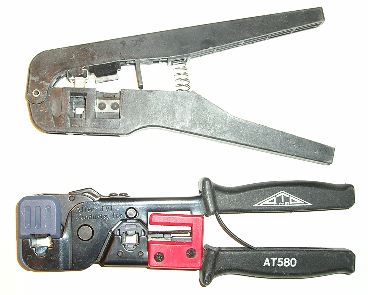 Want to know one of the most frustrating things in amateur radio? Believe it or not, it is not having the right tool for the job. Just as bad is having an inferior tool!
Want to know one of the most frustrating things in amateur radio? Believe it or not, it is not having the right tool for the job. Just as bad is having an inferior tool!
The tools at left; the one on the top is a Radio Shack RJ45 crimping tool, and the one on the bottom is from Allen Telephone. The RS one cost about $15, and the good one was nearly $50. One of the reasons for the difference is the crimping die in the Allen tool can be changed. This allows the tool to crimp not only RJ45 cat and telephone cables, but special ones like those used on Icom microphone cables.
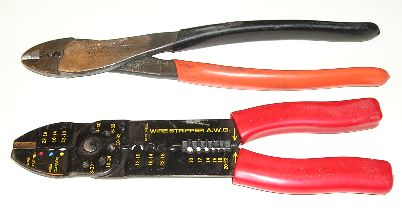 Probably the most used tool is the lowly wiring lug crimp tool. Here too, there is a great difference in quality and capability. The tool (top right) is made by Thomas & Betts, and one I've owned for 50+ years. The one on the bottom is a $6.95 special from a hardware store. Yes, the cheap tool works, but the connections aren't nearly as good as those made by the T&B tool.
Probably the most used tool is the lowly wiring lug crimp tool. Here too, there is a great difference in quality and capability. The tool (top right) is made by Thomas & Betts, and one I've owned for 50+ years. The one on the bottom is a $6.95 special from a hardware store. Yes, the cheap tool works, but the connections aren't nearly as good as those made by the T&B tool.
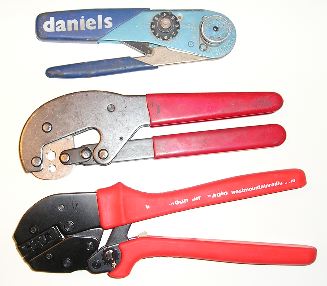 Here are three more specialized tools. The top one is used to crimp D-style connector pins. With the die, it was nearly $50 some 20 years ago! One thing is for sure, it beats having to solder the pins and melting the connector at the same time.
Here are three more specialized tools. The top one is used to crimp D-style connector pins. With the die, it was nearly $50 some 20 years ago! One thing is for sure, it beats having to solder the pins and melting the connector at the same time.
The center tool is designed to crimp F connector sleeves. Although they aren't often used in amateur radio, the tool can be used to crimp large wiring lugs like those used on welding cables. It is also useful for crimping on coaxial connectors, but a specific tool from RF Connection is better yet.
The bottom tool is from West Mountain Radio, and is for Anderson Power Pole connectors. It handles 15, 30, and 45 amp units, which are the most common ones used by amateurs. The larger PP120 and PP180 can be crimped with the aforementioned F connector tool.
While we're on the subject here's another wiring trick. After-market sound system wire, and welding cable are what's referred to as high strand. All this means is, the wire itself is comprised of a large number of smaller strands which makes the wire very flexible. It also wicks solder as a result. Unless you own a solder dip pot, you shouldn't attempt to solder high strand cable. If you do, you run the risk of wicking the solder past the crimp. If the wire is subject to vibration, which it is in a vehicle, this is the first place the wire will fail. Therefore, it behooves you to have the correct crimping tool to do the job right!
TecraTools is one of the better suppliers for all of these tools. There are places where you can buy less expensive tools, but if you want quality, this is the place to go.
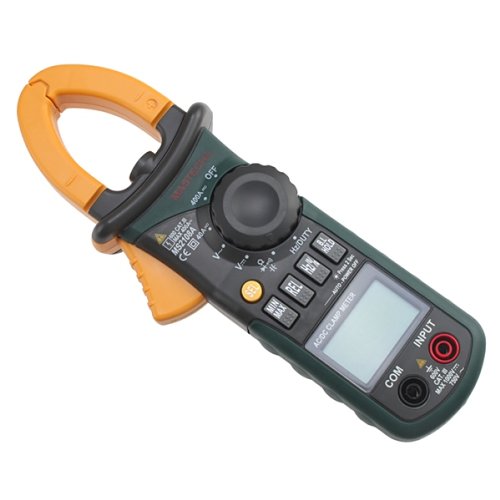 Some might argue, but solvents can be considered tools as well. Every shop should have a can of denatured alcohol on the shelf. Even then, there are times you don't want the denaturing agent either. In that case, a pint of Everclear® is just the ticket. The 190 proof variety is the one of choice. For you teetotalers, Everclear is straight grain (ethyl) alcohol, potent enough that even seasoned drinkers can't take it straight. It makes a wonderful lens cleaner if you use a non-dust wipe. It will also clean off some sticky residues that denatured alcohol cannot.
Some might argue, but solvents can be considered tools as well. Every shop should have a can of denatured alcohol on the shelf. Even then, there are times you don't want the denaturing agent either. In that case, a pint of Everclear® is just the ticket. The 190 proof variety is the one of choice. For you teetotalers, Everclear is straight grain (ethyl) alcohol, potent enough that even seasoned drinkers can't take it straight. It makes a wonderful lens cleaner if you use a non-dust wipe. It will also clean off some sticky residues that denatured alcohol cannot.
Keep acetone, and methyl ketone on the shelf too, as each one has it strengths for some hard-to-tackle clean ups. As with any chemical, careful use is a must, as is adequate ventilation. None of these products should be used around an open flame.
Not all tools are mechanical. The right photo shows a clamp-on ammeter made by Mastech® MS2108A. The Amazon price hovers around $50 delivered. While you can buy better ones, this one is adequate for most amateur applications, including high power ones. It does the nominal volts and ohms too, but can also check filter capacitors.
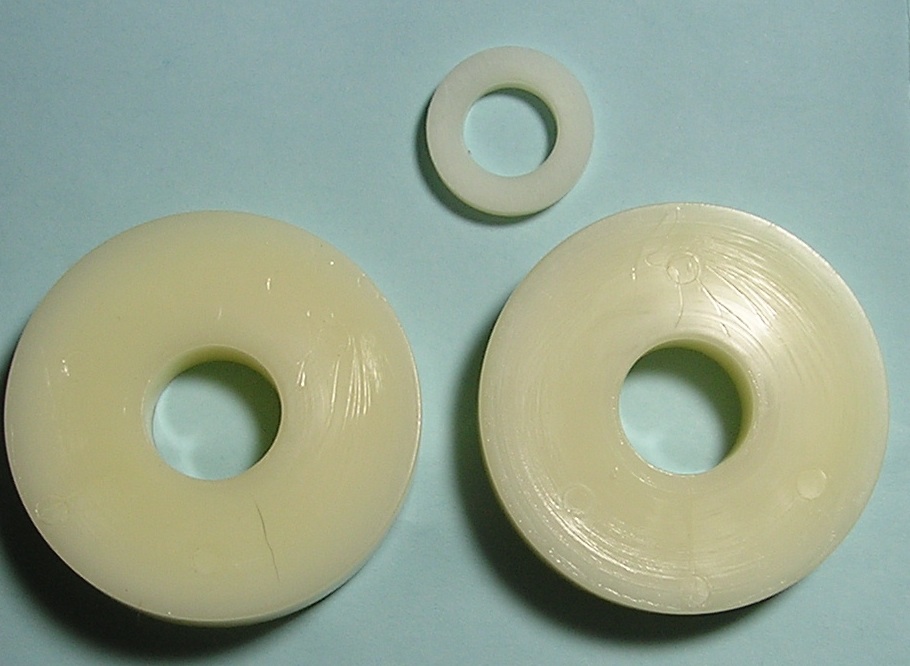 Some antennas require two insulating base washers. One or both usually have a 3/4 inch diameter shoulder one side, and centered drilled for a 3/8 inch bolt. They aren't easy to find, but your local Ace hardware may have what you need. The photo shows some un-sholdered, nylon washers. The large ones are 1 5/8 in diameter, and a 1/2 inch center hole (my local Ace was out of the 3/4 inch center holed ones). The smaller washer is 3/4 OD by 3/8 ID, and will fit the center of the bigger washers.
Some antennas require two insulating base washers. One or both usually have a 3/4 inch diameter shoulder one side, and centered drilled for a 3/8 inch bolt. They aren't easy to find, but your local Ace hardware may have what you need. The photo shows some un-sholdered, nylon washers. The large ones are 1 5/8 in diameter, and a 1/2 inch center hole (my local Ace was out of the 3/4 inch center holed ones). The smaller washer is 3/4 OD by 3/8 ID, and will fit the center of the bigger washers.
The thickness of the bigger washer isn't critical. However, the thickness of the smaller washer will depend on the thickness of the mounting hardware, whatever it is. If you end up having to drill the nylon, it pays to remember that nylon snatches easily. Therefore, it must be held in a vise, and drilled slowly preferably using a drill press.

 It is difficult to find decent fuse holders these days, especially for Maxi sized fuses. When you do find them, connecting large lugs (#6 and larger) can be difficult. The wire size on those with pigtails are always to small for the load, require butt connectors, and there is no convenient way to fasten them down.
It is difficult to find decent fuse holders these days, especially for Maxi sized fuses. When you do find them, connecting large lugs (#6 and larger) can be difficult. The wire size on those with pigtails are always to small for the load, require butt connectors, and there is no convenient way to fasten them down.
The solution is Anderson Power Pole connectors, which are available from West Mountain Radio (and others). The PP15-45 will hold an ATO fuse (40 amp max), and the PP75 will hold a Maxi fuse (80 amp max). The connectors are keyed allowing them to be sandwiched together. The keyway groove (used to lock the connectors together with a small roll pin) can be used to screw them down to a surface.
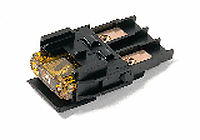 If you use PP connectors as fuse holders, you have to make sure the connector lugs themselves are fully seated into their respective housing. The blades of the fuse needs to be positioned between the lugs and the tension springs built into the housings. If the fuse simply falls out, you haven't done it correctly! Further, the blade thickness of the Maxi fuses makes insertion rather difficult, albeit not impossible. Personally, I prefer to use fuse holders made specifically for the Maxi fuse. Unfortunately, the MAB1 Littelfuse Maxi fuse holder is a discontinued item.
If you use PP connectors as fuse holders, you have to make sure the connector lugs themselves are fully seated into their respective housing. The blades of the fuse needs to be positioned between the lugs and the tension springs built into the housings. If the fuse simply falls out, you haven't done it correctly! Further, the blade thickness of the Maxi fuses makes insertion rather difficult, albeit not impossible. Personally, I prefer to use fuse holders made specifically for the Maxi fuse. Unfortunately, the MAB1 Littelfuse Maxi fuse holder is a discontinued item.
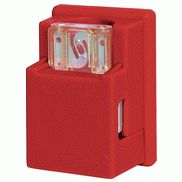 An alternative to the Littelfuse MAB1, is the Bluesea Systems Maxi Fuse Block. They're sold by West Marine, and other full-line marine retailers. It will hold wire sizes up to #4 gauge wire which is adequate for most installations, even high power ones. However, the wire is clamped in using set screws, all but negating the use of high-strand wire, like welding cable unless you use crimped-on sleeves made for the purpose. Like the MAB1, it does come with a protective cover, albeit a bit larger in size. The cover is available in both red, and black.
An alternative to the Littelfuse MAB1, is the Bluesea Systems Maxi Fuse Block. They're sold by West Marine, and other full-line marine retailers. It will hold wire sizes up to #4 gauge wire which is adequate for most installations, even high power ones. However, the wire is clamped in using set screws, all but negating the use of high-strand wire, like welding cable unless you use crimped-on sleeves made for the purpose. Like the MAB1, it does come with a protective cover, albeit a bit larger in size. The cover is available in both red, and black.
Anderson Power Pole connectors are very convenient, and make very secure connections. Once you start using them, you'll enjoy their ease of installation. That is, if you bite the bullet for the crimping tool. While it costs about $50, it sure shortens installation time. Probably the toughest lesson to learn when you're using zip-type power cords, is orientating the connector pins on the ends of the wire correctly. If you'll read the directions that came with the crimper, you'll do it right the first time. But... if you're into using the PP75, PP120, and PP180 connectors, you'll need Anderson's commercial-grade crimper (>$200).
By the way, there is nothing wrong with the old round 5AG fuses, except they're getting hard to find as are their holders. They're also limited to 50 amps (Maxi fuses go up to 80 amps), and thus may not be suitable in some high-power applications. Incidentally, 5AG fuses over 30 amps are no longer made.
Don't use car polish on anything with RF around it. The majority of car polishes are conductive which speaks volumes. Further, the stuff can seal in moisture just as good as it seals it out. If you have to protect your antenna and/or mount from the ravages of weather, use RainX. Just remember, it can discolor some plastics, so exercise care.
Don't forget grommets. If a wire goes through a hole, it should do so through a grommet. Sometimes, in the case of firewall penetration, this allows fumes and moisture to get into the cabin. Just about every type of sealing material used to seal grommets has some drawback, except for Strip-Caulk®, also known as Dum Dum. It is made by 3M, and is carried by most auto parts stores. Although it is gooey, it can be removed even years later. What little residue is left, can be easily removed with denatured alcohol.